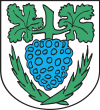Jastrowie
Jastrowie [jasˈtrɔvʲɛ] (German: Jastrow) is a town in Poland of over 9,000 inhabitants in Złotów County, Greater Poland Voivodeship. It has 8,900 inhabitants (1998) and lies on the edge of the Gwda river valley. The town is located on the Oska stream.
Jastrowie | |
|---|---|
 Church of the Holiest Virgin Mary, the Queen of Poland | |
 Flag  Coat of arms | |
 Jastrowie | |
| Coordinates: 53°25′18″N 16°48′56″E | |
| Country | |
| Voivodeship | Greater Poland |
| County | Złotów |
| Gmina | Jastrowie |
| Area | |
| • Total | 72.27 km2 (27.90 sq mi) |
| Population (2006) | |
| • Total | 8,403 |
| • Density | 120/km2 (300/sq mi) |
| Postal code | 64-915 |
| Website | http://www.jastrowie.pl |
History
Jastrowie was one of the southernmost centres of the Pomeranians. In the beginning of the 14th century it belonged to the Ujście castellany. On May 5, 1602, the town received the city rights granted by Piotr Potulicki and confirmed by King Sigismund III Vasa. In the 17th century the town developed quickly. New inhabitants arrived, including Pomeranians, settlers from Scotland, and Jews.
After the Partitions of Poland the town was incorporated into Prussia. In 19th century Jastrowie (then called Jastrow in German) became one of the most important centres of horse trade. During World War II, Jastrowie was an important point of Pommernstellung (Wał Pomorski), one of the most important German lines of fortification in the East. The town was eventually captured by the Red Army on 2 February 1945.
Currently Jastrowie is the site of several wood and bicycle factories. It was part of the Piła Voivodeship from 1975 until 1998, when the administrative region was superseded by the Greater Poland Voivodeship. Jastrowie's most important cultural event is its International Folk Festival "Bukowińskie Spotkania".
Sites of interest
- Town Market (18th century)
- City House (16th century)
- St. Mary's Queen of Poland Church (1882)
- Michael's Archangel Church (1913).
| Wikimedia Commons has media related to Jastrowie. |